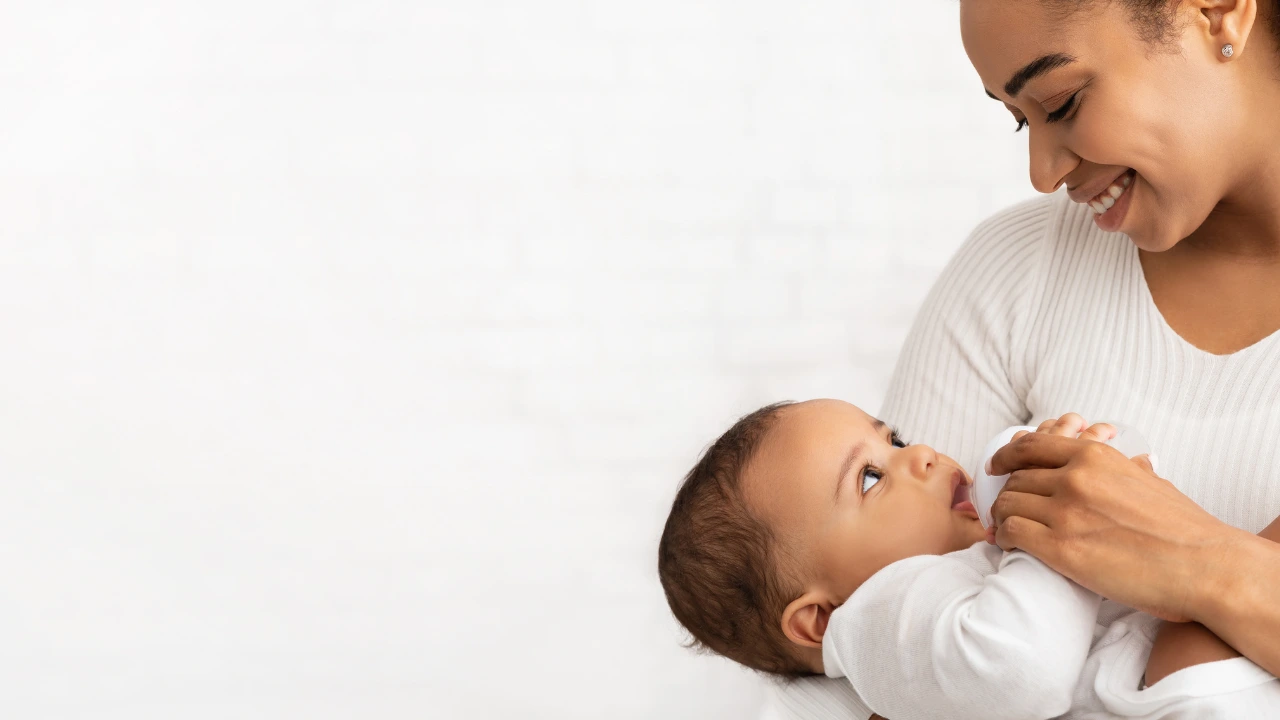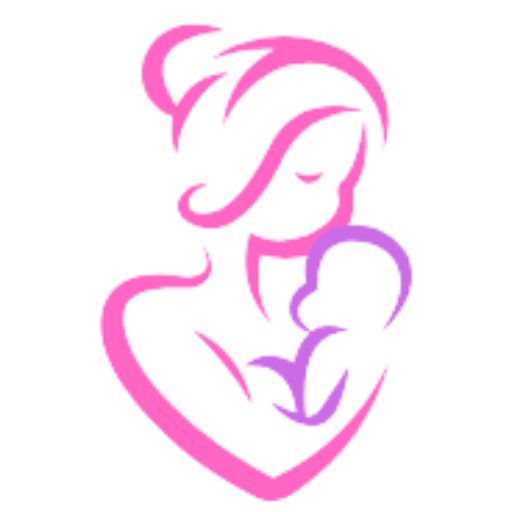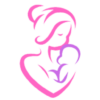
ፎርሙላ እየመገቡ፣ ብቻውን በማፍሰስ፣ ወይም ጡት ማጥባት እና ጡጦ ማጥባትን በማዋሃድ፣ እነዚህ ምክሮች ጠርሙሱን በደህና እና በብቃት ለመመገብ ሊረዱዎት ይችላሉ። አዲስ የተወለደውን ህፃን በጠርሙስ ለመመገብ ከሚያስፈልጉት ቁልፍ ነገሮች አንዱ ብዙ አየር እንዳይዋጥ ማድረግ ነው, ይህም ጋዝ እንዲፈጠር ሊያደርግ ይችላል. የልጅዎን የረሃብ ምልክቶች መከተልም አስፈላጊ ነው.
በዚህ ጽሑፍ ውስጥ
አዲስ የተወለደውን ጠርሙስ መመገብ
በብቸኝነት ፓምፕ እያደረጉ ወይም እየተጠቀሙ ከሆነ ፎርሙላ, አዲስ ለተወለደ ልጅዎ ወዲያውኑ ጠርሙስ ይሰጣሉ. በሚጠባው reflex ምክንያት፣ በቀላሉ ሊወስዱት ይችላሉ። (ልጅዎ ካለ ልዩ ጠርሙሶች አሉ ያለጊዜው ወይም የላንቃ መሰንጠቅ አለበት።)
ጡት እያጠቡ ከሆነ እና በቀመር ማሟላት (ጥምር መመገብ ተብሎም ይጠራል)፣ ዶክተሮች እና የጡት ማጥባት አማካሪዎች ከተቻለ ጡጦ ለመስጠት ልጅዎ 3 ሳምንት እስኪሆነው ድረስ እንዲጠብቁ ይመክራሉ። በዚህ መንገድ፣ እርስዎ እና ልጅዎ ጡት በማጥባት ምቹ ይሆናሉ እና የጡት ወተት አቅርቦት ከልጅዎ ፍላጎቶች ጋር ይጣጣማል። ነገር ግን ከዚያ በፊት ጠርሙስ መስጠት ካስፈለገዎት, አይጨነቁ - ይህ ማለት በተሳካ ሁኔታ ጡት ማጥባት አይችሉም ማለት አይደለም!
የተራቡ ምልክቶች እንደታዩ አራስ ልጅዎን በፍላጎት ይመግቡ። ምግብ ከመብላታቸው በፊት በጣም ከተበሳጩ፣ ፎርሙላቸውን ወይም የጡት ወተትን መጠጣት ላይ ችግር ሊገጥማቸው ይችላል። የሕፃን ረሃብ ምልክቶች የሚከተሉትን ያካትታሉ:
- ከንፈራቸውን እየላሱ
- አፋቸውን ከፍተው
- ምላሳቸውን ማውጣቱ
- ሥር መስደድ (መንጋጋቸውን፣ አፋቸውን ወይም ጭንቅላታቸውን ጡትዎን መፈለግ)
- ነገሮችን መምጠጥ
- ግርግር
ፎርሙላ እየመገቡ ወይም ብቻ የሚስቡ ከሆነ፣ ለመጀመሪያው ሳምንት፣ በየ 2 ወይም 3 ሰዓቱ አዲስ ለተወለደ ህጻን 1 እስከ 2 አውንስ ፎርሙላ ወይም የጡት ወተት ያቅርቡ። መጀመሪያ ላይ አዲስ የተወለዱ ሕፃናት በአንድ ጊዜ ግማሽ ኦውንስ ብቻ ሊወስዱ ይችላሉ.
አዲስ የተወለዱ ሕፃናት በየ24 ሰዓቱ ከስምንት እስከ 12 ጊዜ ይበላሉ። ከመጀመሪያው ሳምንት በኋላ፣ ልጅዎ በየ 3 እና 4 ሰዓቱ ከ2 እስከ 3 አውንስ ሊወስድ ይችላል።
አዲስ የተወለደ ሕፃን በመመገብ ወቅት ቢተኛ፣ በቂ የሰውነት ክብደት እንዲጨምር እነሱን መቀስቀስ እና እንዲመገቡ ማበረታታት ሊኖርብዎ ይችላል። እና ልጅዎ በመጀመሪያዎቹ ሳምንታት በቀጥታ ከ4 ሰአት በላይ የሚተኛ ከሆነ፣ ለመመገብ መቀስቀስ ያስፈልግዎታል። (ይህ ብዙውን ጊዜ አስፈላጊ የሚሆነው አራስ ልጅዎ ያለጊዜው ካልተወለዱ በስተቀር የተወለደ ክብደታቸው እስኪያገኝ ድረስ ብቻ ነው።)
ልጅዎን በጠርሙስ እንዴት እንደሚመግቡ
ልጅዎን በጠርሙስ ለመመገብ ቁልፉ በ 45 ዲግሪ ማዕዘን ላይ በእጆችዎ ውስጥ ይይዛቸዋል. ይህ የሚውጡትን የአየር መጠን እንዲቀንስ ይረዳል፣ ይህ ደግሞ በሆድ ውስጥ ያለውን የማይመች ጋዝ መጠን ይቀንሳል።
ልጅዎ የሚውጠውን የአየር መጠን ለመቀነስ የጡት ጫፉ ሙሉ በሙሉ በፎርሙላ ወይም በጡት ወተት መሙላቱን እርግጠኛ ይሁኑ። ልጅዎ በመመገብ መካከል የተወዛወዘ ከመሰለ፣ ከመቀጠልዎ በፊት ይቧቧቸው።
ልጅዎ በሚጠጣበት ጊዜ ብዙ ጫጫታ የሚጠጡ ድምፆች ከሰሙ፣ በጣም ብዙ አየር እየወሰዱ ሊሆን ይችላል። አነስ ያለ አየር እንዲዋጡ ለመርዳት በትክክለኛው ማዕዘን ላይ እንደያዟቸው ያረጋግጡ።
ትልልቅ ሕፃናት የራሳቸውን ጠርሙስ ሊይዙ ይችሉ ይሆናል፣ነገር ግን ጠርሙስ በጭራሽ አያራግፉም - ልጅዎ እንዲታነቅ ሊያደርግ ይችላል።
የተጣደፈ ጠርሙስ መመገብ ከመጠን በላይ ማጥባትን ለመከላከል ልጅዎን ምን ያህል እንደሚበሉ እንዲቆጣጠር የሚያደርግ አንዱ ታዋቂ ጡጦ መመገብ ዘዴ ነው። ትክክለኛውን ጠርሙዝ መምረጥዎን ያረጋግጡ (ዘገምተኛ ፍሰት ያለው ሰፊ የጡት ጫፍ ይፈልጉ)፣ በየ20 እና 30 ሰከንድ እረፍት ይውሰዱ እና የልጅዎን ሙላት ምልክቶች ይመልከቱ (ለምሳሌ ከጠርሙሱ ላይ ጭንቅላታቸውን ማዞር)።
የቱንም ያህል ጠርሙስ ቢመግቡ፣ የመጥገቡ ምልክቶች ሲታዩ ልጅዎ መብላቱን እንዲያቆም ያድርጉ። ልጅዎ አዲስ የተወለደ ካልሆነ ወይም በክብደት መጨመር ላይ ችግር ካላጋጠመው በስተቀር ፍላጎታቸውን ካጡ ወይም ከተኙ በኋላ ጠርሙስ እንዲጨርሱ አያበረታቷቸው።
የተለመዱ የጡጦ-መመገብ ጥያቄዎች
የሕፃን ጠርሙስ እንዴት እሠራለሁ?
ንጹህ ጠርሙሶችን በመጠቀም ጠርሙሱን በቀመር ወይም በጡት ወተት ሙላ። ከውሃ ጋር ያዋህዱትን ፎርሙላ ከተጠቀሙ በመጀመሪያ ውሃውን ይለኩ እና ከዚያም ፎርሙላ ይጨምሩ. (ምን ይመልከቱ የውሃ ዓይነት ቀመር ለመሥራት ምርጥ ነው።)
ለአንድ ቀን የሚሆን የቀመር ጠርሙሶች በማቀዝቀዣ ውስጥ እስከ 24 ሰአታት ድረስ ማዘጋጀት እና ማከማቸት ይችላሉ.
የጡት ወተት እየተጠቀሙ ከሆነ፣ የጡት ወተት ለምን ያህል ጊዜ ትኩስ እንደሚቆይ ለማስታወስ “የ4 ደንብ”ን ይጠቀሙ፡ 4 ሰአት በክፍል ሙቀት እና 4 ቀናት በማቀዝቀዣ ውስጥ። እንዲሁም የጡት ወተት ማቀዝቀዝ እና በ 6 ወራት ውስጥ ወይም እስከ አንድ አመት ድረስ መጠቀም ይችላሉ.
ልጄን ምን ያህል ጊዜ ጠርሙስ መመገብ አለብኝ?
ሕፃናት ይለያያሉ፣ ግን በአጠቃላይ ምን እንደሚጠብቁ እነሆ።
- ለመጀመሪያዎቹ ጥቂት ሳምንታት በየሁለት ወይም ሶስት ሰዓቱ ወይም ልጅዎ የተራበ በሚመስልበት ጊዜ ጠርሙሱን ያቅርቡ። በመጀመሪያ፣ አዲስ የተወለዱ ሕፃናት በአንድ ጊዜ ግማሽ ኦውንስ ብቻ ሊወስዱ ይችላሉ፣ እያንዳንዱን አመጋገብ ለመጀመሪያው ሳምንት እስከ 1.5 እስከ 2 አውንስ ድረስ እየሰሩ ነው። ከመጀመሪያው ሳምንት በኋላ፣ በአንድ መመገብ ከ2 እስከ 3 አውንስ ያህል ይወስዳሉ።
- ከአንድ ወር ገደማ በኋላ፣ ልጅዎ በየሶስት እና አራት ሰአቱ ከ3 እስከ 4 አውንስ ሊወስድ ይችላል። ልጅዎ ሲያድግ, ይህ መጠን በሚቀጥሉት በርካታ ወራት ውስጥ ቀስ በቀስ ይጨምራል.
- በ6 ወራት ውስጥ ልጅዎ በቀን አራት ወይም አምስት ጊዜ ከ6 እስከ 8 አውንስ ሊወስድ ይችላል።
የሕፃናት ሐኪምዎ የልጅዎን እድገት ይከታተላሉ፣ ይህም በቂ ምግብ እያገኘ መሆኑን በጣም ጥሩ አመላካች ነው።
ልጄ ጠርሙስ ካልጨረሰ ለበኋላ ማስቀመጥ እችላለሁ?
ከልጅዎ ምራቅ የሚመጡ ተህዋሲያን በጠርሙሱ ውስጥ ካለው ፈሳሽ ጋር ይቀላቀላሉ, ይህም ወደ ብክለት ያመራል.
ልጅዎ መመገብ ከጀመረ በአንድ ሰአት ውስጥ ፎርሙላውን ካላጠናቀቀ፣ የተረፈውን ይጣሉት። የጡት ወተት ፀረ-ባክቴሪያ ባህሪያት ለሁለት ሰዓታት የመቆያ ህይወት ይሰጣሉ. ከዚያ በኋላ ይጣሉት.
ጠርሙስ ለማሞቅ በጣም ጥሩው መንገድ ምንድነው?
ለልጅዎ ከመሰጠትዎ በፊት ፎርሙላ ወይም የጡት ወተት ለማሞቅ ምንም የጤና ምክንያት የለም፣ ነገር ግን ልጅዎ በዚህ መንገድ ይመርጥ ይሆናል።
አንድ ጠርሙስ የቀዘቀዘ የጡት ወተት ወይም ፎርሙላ ለማሞቅ ከሚከተሉት ዘዴዎች ውስጥ አንዱን ይጠቀሙ፡-
- ሙቅ በሆነ ጎድጓዳ ሳህን ውስጥ ያስቀምጡ - ሙቅ አይደለም - ውሃ እስኪሞቅ ድረስ እስከ 15 ደቂቃዎች ድረስ. የውኃው መጠን ከጠርሙ ጫፍ በታች መሆን አለበት. ፈሳሹ በደንብ እንዲሞቅ ለማድረግ ጠርሙሱን ጥቂት ጊዜ በቀስታ አዙረው።
- ጠርሙሱን በሙቅ ውሃ ስር አስቀምጡት ሙቅ ውሃ እስኪሞቅ ድረስ, ከአንድ እስከ ሁለት ደቂቃዎች. ውሃ በጡቱ ጫፍ ላይ ወይም በጠርሙሱ ውስጥ እንዳትገቡ ይጠንቀቁ.
- የጠርሙስ ማሞቂያ ይጠቀሙ።
በጭራሽ አይጠቀሙ ጠርሙስ ለማሞቅ ማይክሮዌቭ የጡት ወተት ወይም ድብልቅ. ማይክሮዌቭ ምድጃ እኩል ባልሆነ ሁኔታ ይሞቃል, ስለዚህ በፈሳሽ ውስጥ የሚቃጠሉ ሙቅ ኪሶችን ይፈጥራል. ማይክሮዌቭ (ማይክሮዌቭ) ንጥረ-ምግቦችን (ንጥረ-ምግቦችን) መበላሸትን ሊያስከትል ይችላል.
የሕፃን ጠርሙሶችን እና የጡት ጫፎችን እንዴት ማፅዳት እችላለሁ?
ምንም አይነት የጽዳት ዘዴ ቢጠቀሙ, ከመጀመርዎ በፊት እጅዎን በደንብ መታጠብዎን ያረጋግጡ.
ብርጭቆ፣ ብረት ወይም የሲሊኮን ጠርሙሶች፡- የሞቀ ውሃን እና ሙቅ ማድረቂያ ዑደትን በሚጠቀም የእቃ ማጠቢያ ዑደት ውስጥ ያካሂዷቸው። በአማራጭ፣ በሞቀ እና በሳሙና ውሃ ውስጥ በእጅ ይታጠቡዋቸው እና በንፁህ የእቃ ማጠቢያ ፎጣ ወይም በወረቀት ፎጣ ላይ እንዲደርቁ ያድርጉ።
የፕላስቲክ ጠርሙሶች; ሙቀት ፕላስቲኮች ጎጂ ኬሚካሎችን እንዲለቁ ስለሚያደርግ የአሜሪካ የሕፃናት ሕክምና አካዳሚ የፕላስቲክ ጠርሙሶች በእቃ ማጠቢያ ውስጥ እንዳይገቡ ወይም በሚፈላ ውሃ ውስጥ እንዳይገቡ ይመክራል። በምትኩ፣ በእጅ በሞቀ፣ በሳሙና ውሃ ታጥባቸው እና በንፁህ የእቃ ማጠቢያ ፎጣ ወይም በወረቀት ፎጣ ላይ አየር እንዲደርቁ ያድርጓቸው።
የጡት ጫፎች እና ቀለበቶች; እጅን እየታጠብክም ሆነ እቃ ማጠቢያውን እየተጠቀምክ የጡት ጫፎቹን እና ቀለበቶቹን ለይተህ ከምንጭ ውሃ በታች እጠቡት። በእቃ ማጠቢያ ውስጥ በተዘጋ ቅርጫት ወይም የተጣራ የልብስ ማጠቢያ ቦርሳ ውስጥ ያስቀምጧቸው. ዑደቱ ሲጠናቀቅ ሙሉ በሙሉ ደረቅ ካልሆኑ አየር ለማድረቅ በንፁህ የእቃ ማጠቢያ ፎጣ ወይም በወረቀት ፎጣ ላይ ያስቀምጧቸው.
በእጅ ለመታጠብ የታጠቡ የጡት ጫፎችን እና ቀለበቶችን በንፁህ የሳሙና ሙቅ ውሃ ገንዳ ውስጥ ያስቀምጡ። የጨቅላ ህጻን ምግቦችን ለማጠብ ብቻ የሚያገለግል ንጹህ ብሩሽ ያጽዱ። ንፁህ መሆናቸውን ለማረጋገጥ በጡት ጫፎቹ ውስጥ ውሃ አፍስሱ። በሚፈስ ውሃ ስር ያጥቧቸው, ከዚያም በንጹህ ማጠቢያ ፎጣ ወይም በወረቀት ፎጣ ላይ አየር ያድርጓቸው. ገንዳውን በሙቅ እና በሳሙና ውሃ ያጠቡ እና አየር እንዲደርቅ ያድርጉት።
የሕፃን ጠርሙሶችን ማምከን አለብኝ?
የግድ አይደለም። በሚከተሉት ሁኔታዎች ጠርሙሶችን፣ የጡት ጫፎችን እና ቀለበቶችን ማምከን በብዛት ይመከራል።
- ለመጀመሪያ ጊዜ አዲስ (ወይም በእጅ ወደ ታች) ጠርሙሶች፣ የጡት ጫፎች እና ቀለበቶች ሲጠቀሙ
- የጉድጓድ ውሃ ካለዎት ወይም ስለ የውሃ አቅርቦትዎ ጥራት ካሳሰበዎት
- ልጅዎ ገና ሳይደርስ ከተወለደ ወይም የበሽታ መከላከል አቅሙ ደካማ ከሆነ
- ልጅዎ ከታመመ (እርስዎ በሚመገቡበት ጊዜ ባክቴሪያዎችን ወይም ጀርሞችን እንደገና እንዳያመጡ ለመከላከል)
ጠርሙሶችን ማምከን ስለመቻልዎ ጥያቄዎች ካሉዎት የልጅዎን አገልግሎት ሰጪ ያነጋግሩ። እንዴት እንደሚደረግ እነሆ፡-
- ብሊች፡ ጠርሙሶችን በጋሎን (16 ኩባያ ወይም 128 አውንስ) ውሃ 2 የሻይ ማንኪያ ሽታ የሌለው የቢሊች መፍትሄ በንጹህ ማጠቢያ ገንዳ ውስጥ ቢያንስ ለ2 ደቂቃ ያርቁ። አትታጠብ. ማንኛውም የቀረው ማጽጃ ሲደርቅ ይሰበራል። የፕላስቲክ ጠርሙስ ክፍሎችን ለማፅዳት ብሊች መጠቀምም ይችላሉ።
- የፈላ ውሃ; ጠርሙሶችን ቢያንስ ለአምስት ደቂቃዎች በሚፈላ ውሃ ውስጥ ያጠቡ ።
- እንፋሎት፡ የጠረጴዛ ወይም ማይክሮዌቭ ጠርሙስ ስቴሪዘርን ይጠቀሙ። የአምራቹን መመሪያዎች ይከተሉ.
- የእቃ ማጠቢያ; ጠርሙሶችን በእቃ ማጠቢያ ዑደት ውስጥ ሙቅ ውሃ እና ሙቅ ማድረቂያ ዑደት ወይም የንፅህና መጠበቂያ ቦታን በመጠቀም ያሂዱ።
ማሳሰቢያ: የፕላስቲክ ጠርሙሶችን ለማጽዳት ሙቀትን ላይ የተመሰረቱ ዘዴዎችን - የፈላ ውሃን, የእንፋሎት ወይም የእቃ ማጠቢያ ማሽን አይጠቀሙ. ሙቀት ፕላስቲኮች ጎጂ ኬሚካሎችን እንዲለቁ ሊያደርግ ይችላል.
ጠርሙሶቹ ከንጽህና በኋላ እርጥብ ከሆኑ በንጹህ ማጠቢያ ፎጣ ወይም በወረቀት ፎጣ ላይ አየር እንዲደርቅ ያድርጉ.
ተጨማሪ ያንብቡ


አስተያየት ጨምር